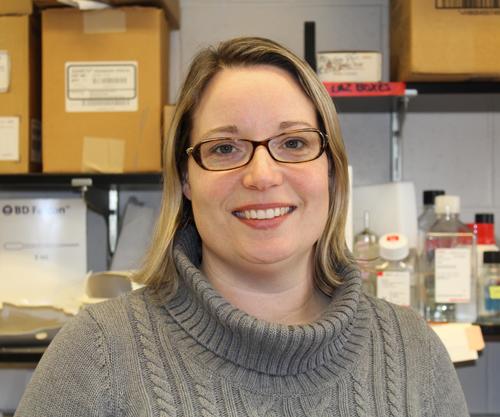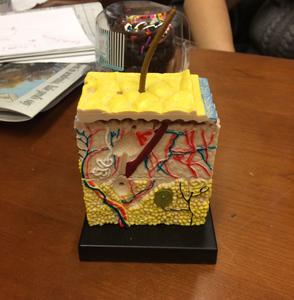
A member of the Yale faculty since 2009, Valerie Horsley is an associate professor of molecular, cellular and developmental biology, with joint appointments as associate professor of dermatology and in the Yale Stem Cell Center and Yale Cancer Center. Her laboratory in Kline Biology Tower consists of a team of researchers investigating the mechanisms underlying tissue growth, maintenance, and regeneration.
After earning her B.S. from Furman University and Ph.D. at Emory University, Horsley began her academic career as a postdoctoral fellow at Rockefeller University in New York City. Since her arrival in New Haven, she has been an active leader in faculty development efforts in the Faculty of Arts and Sciences and across the university more broadly, organizing an FAS junior faculty group and spearheading a child care initiative that resulted in establishment of The Nest at Yale.
In an interview in her office, Horsley reflected on her research of the body’s largest (and largely underappreciated) organ; on cultivating a culture of mentorship; and on thinking of teaching as a series of experiments.
Q. How did you gravitate toward studying human tissue, and can you teach us briefly about your current research?
A. I’ve always been interested in our bodies—in how we’re able to live for ninety years, sometimes, and on most days be healthy. Our bodies are made up a group of organs or tissues that work together to enable us to do that, and I’m interested in how all the cells and molecules and tissues work together to make that happen.

A three-dimensional model of a cross-section of skin tissue sits on Valerie Horsley’s desk in Kline Biology Tower. Photograph by Alison Coleman for the FAS Dean’s Office.
My main focus is on the skin. This [indicating three-dimensional model] is the skin; it has multiple layers. The top layer—what you see on the outside—is what most people study. And these are keratinocytes—made up of proteins called keratins, primarily, which makes them very resilient so you can poke [the skin] and it doesn’t break. And those cells are also tightly adherent to each other, so you can stretch it and move it, and they sit on top of a layer, the dermis, that is full of many cell types: blood vessels; lymphatic vessels that allow our immune cells to migrate around our bodies; muscles that attach to a hair, allowing us to have goosebumps; sweat glands. And inside, there are many other types of cell whose functions we really don’t yet understand. And the bottom is a layer of fat, which is what my lab has mainly been studying. The field has largely ignored it, so we started asking, why is there this layer of fat associated with the skin? What is it doing? Our basic work is to identify the cells in this tissue and how they change when you wound the tissue. From there, we can understand the molecules, hopefully leading to better treatments for skin diseases.
Q. I read an article on your lab’s website about the successful skin transplant that was done recently on a seven-year-old Syrian refugee. There are so many potential outcomes of your research—what excites you the most about its potential impact?
A. The interesting thing is that we think of our skin, probably, the most of any other tissue in our body. When we wake up, we think, how does my face look? People look at their hands a lot. And people don’t think skin is a medically imperative tissue, but it is. There are babies born with blistering skin diseases, which is a terrible existence. There are a lot of people trying to figure out how to treat those patients.
For me, I’m really interested in wound healing right now. I’ve always been interested in asking, if you break a tissue, how does it fix itself? Because that’s a lot of what happens as we age: our tissues aren’t able to repair themselves as effectively. And I’ve recently become aware of the fact that we treat our wounds pretty similarly to how we did in the early 1800s. The therapies for wound care haven’t really advanced. So there’s a lot to learn and a lot of potential.
Q. On your lab’s website, I also noticed a strong emphasis on carving out space to talk about mentoring; even on the home page, you give voice to expectations that include but go beyond research integrity. Can we talk about that? I know that it’s important to you.
A. This was spurred by the transition to having my own independent lab. I was trained to be able to do experiments, create data, interpret data, write papers, write grants. But then, you get into an independent position, and you’re in an office, you have to fill that office with people, and equipment and cells and material, and make the whole thing run. There’s no training for that. So I asked myself, how did my mentors deal with this? But I also really wrestled with the question of what mentorship looks like, and what my own mentoring style should be.
So I started reading, and I was inspired by two main people. Uri Alon, who gave YouTube talks, has a TED talk, and is an improv actor, explains that in improv, you go into a group of people and say “yes…and then” and ideas develop from there. In science, we’re critical, so we say, “but”; it’s a very different kind of mentality. I also was inspired by a woman named Brené Brown, who’s a shame researcher at the University of Houston. She has one of the most famous TED talks. She talks about how you have to be vulnerable to bring your true self to an experience, and that leads to connection.
These two things came to me at a time in my life when I was thinking about how to build the group of people in my lab. So, I started thinking about how we, as scientists, inspire creativity and motivate people. What I realized is that part of the reason there aren’t so many women or minorities in science is that the model has been “but…but…but” rather than “and…and…and.” And yes, we do need to be critical: there are moments in the progression of a scientific project when the “but…but…but” is appropriate. But the majority of the time, you’re trying to discover something, and that’s a scary enterprise. Once you have the product, that’s when you should be critical, but that’s such a small amount of the time of the life of a project.
It’s incredibly important to me to make sure that the people in this group leave my lab loving science, and that they feel that I saw them as a person and supported them as a person—not just as a data generator.
Q. You are a member of the planning committee for the new Yale Science Building. What do you hope science at Yale will look like ten years from now?
A. Historically, Yale has been very good at fostering individuals. More and more, science is becoming much more collaborative. It requires expertise that you can’t hold in your own group. That’s one thing that will be a great benefit to the new science building and the way it will be laid out. I will get to run into my colleagues a lot more often, and so will my lab, and that will foster those interactions. But also, I’m hoping that there will be mechanisms to bring people together more rather than keeping them in their own little silos. That can be challenging, because we only have a certain amount of time. Time is really the limiting factor. But fostering community is really essential for all of these things that we’ve talked about: for making better science, for keeping people happy at Yale, for making it a more diverse faculty and more diverse environment.
Q. Let’s talk a bit about teaching. What have your experiences been?
A. I taught for several years with [Sterling Professor of Molecular, Cellular, and Developmental Biology] Tom Pollard in an upper-level cell biology course that enrolled as many as 120 students. It was great to teach with him because I learned a lot—he was an invested mentor in teaching the course.
It was during that time that [Howard Hughes Medical Institute Professor and Frederick Phineas Rose Professor] Jo Handelsman came to our department and started to talk about strategies for teaching, data on how students learn most effectively—how science needs to be taught in a different way. That was really timely for me, because it influenced how I developed my lectures. At the same time, we had started a new foundations in biology series, and I was asked to teach in the cell biology portion, and now that’s about 220 students—it’s a huge course—but I was able to build in some of the active-learning strategies that I had picked up. It’s been fun to engage the students, to get them up and doing things that are different. They’ll say, “I think that’s silly,” but then on the quiz they remember [what they learned]. And that’s the whole point.
Thinking of teaching as doing experiments makes you bolder and more willing to accept the things that don’t go so well. I try to throw in a few experiments every year to see what sticks.
Q. And your graduate students—are there things that they’ve gone on to do that you’re particularly proud of?
A. One of the things I really love about my job is watching students develop over their time in my lab. I’m happy for everyone who leaves from my lab and figures out what they want to do next. I’ve had students go on to do postdocs and students who end up as editors. With each individual in my lab, we talk every year—I ask, what are your goals for the next year, and what are your career goals after you leave my lab? Because it’s never too early to start thinking about that. You should always be planning and thinking.
Q. What is your life like away from campus?
A. At home I have two daughters, who are six and eleven years old. Since we moved here I’ve been going into each of their classrooms once a year to give presentations about science. They’re still young, but I think they’re proud of the work I do.
Reported and written by Alison Coleman for the FAS Dean’s Office